I played the (not so) ‘glamorous assistant’ role in a fabulous break-out session led by NHS Horizons’ Zoe Lord on ‘Liberating Structures’ – at Q’s recent UK-wide community event in Birmingham.
The 65 participants really enjoyed diving pretty much straight into trying out four of the 33 Liberating Structures. Feedback found it to be the most highly rated of all the breakouts.
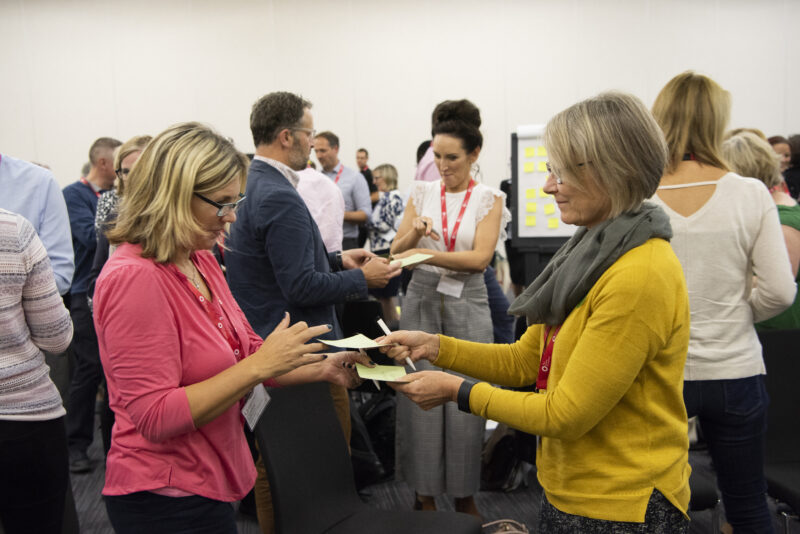
For those who’ve not come across them before, Liberating Structures are a collection of tools for groups to use to achieve their goals around collaboration, planning, learning, sharing and more. You’ll probably know some already (eg Open Space), many you might not (eg TRIZ, Troika Consulting).
Pacy, enjoyable, practical stuff to take back and use straightaway
What sets them apart from many tools is that they steer clear of the need for a ‘heroic’ facilitator, – and somehow manage to be seriously fun.
Compared to the usual – too often boring and unproductive – menu of powerpoints, status reports, brainstorms etc, Liberating Structures really engage everyone, give people space to be heard, to be creative.
Q members at the workshop could instantly see the relevance for their own improvement work:
- “Pacy, enjoyable, practical stuff to take back and use straightaway”
- “Excellent, good take home tools. Really relevant to my area of work”
- “I have already tried a couple out at events since the session”
- “I will be looking to use some of the tools to help with engaging service users, volunteers and staff with my work on embedding coproduction in the organisation I work for”
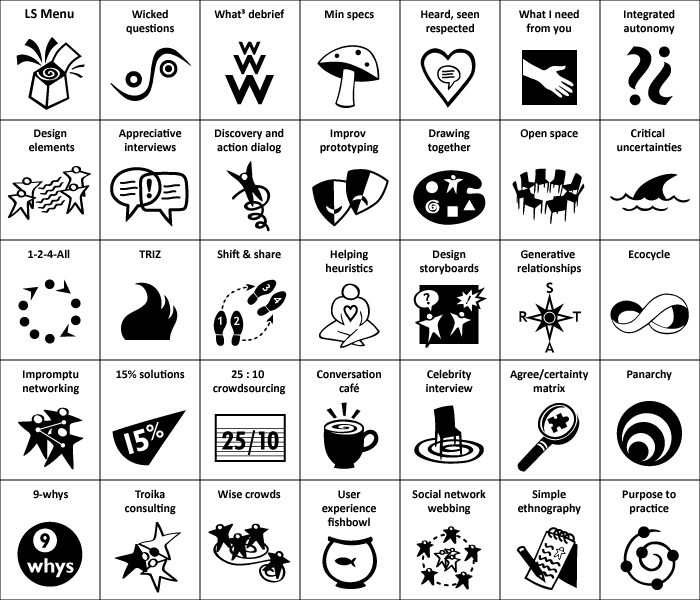
We tried out four Liberating Structures during the workshop.
They were:
- TRIZ
A 35-min exercise that creates space for innovations by challenging sacred cows safely and encouraging creative destruction and heretical thinking. A favourite with NHS Horizons team members including Zoe. - 25/10 Crowd Sourcing
A large crowd can generate and sort their boldest ideas in under 30 minutes – it always amazes me that something involving so much movement and music, can come up with such concrete, helpful outcomes! - Troika Consulting
Everyone in the room gets practical and imaginative help from their colleagues immediately, in 30 minutes; strikingly different from most formats where only one or two people might get help. - 1-2-4-All
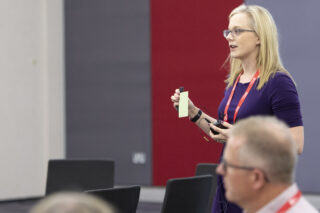
Zoe Lord explains the next Liberating Structure to the room This brief – 12 minute – practice engages everyone in generating questions, ideas and suggestions. One to use regulary; similar to ‘Think-Pair-Share’.
For the 25/10 Crowd Sourcing, we asked the question: ‘What is your one big idea that you would love the Q Community to do next?’
The output is a ‘top 10’ of the most popular ideas. Here are ours:
- Rip up every single RAG report that they find
- Q University – accredited online learning
- Extend remit to clinicians in training
- Engage with younger generation
- Collectively all work together to finally fix emergency/urgent care once and for all
- Offer peer coaching to help deliver QI projects
- Reducing the stigma around mental illness and achieving parity of esteem between ‘physical’ and ‘mental’ health. Step 1: Open a discussion between professionals
- Move the focus from achieving ‘affordable quality’ to achieving excellence
- Test different ways of running our health and social care systems i.e. Buurtzorg combined communities and see whether we could start to unpick the current system to make it fit for purpose
- Focus on solutions for patients navigating complex health / social care / housing systems
Here’s the full list of members big ideas for Q (with Q members’ scores out of 25), in order of popularity.
Even the dozens of ideas outside the top 10 are rather fabulous. They include: doing a Q Lab on Acute Hospital patient flow; a database to share successful QI projects; an international exchange programme; virtual action learning sets; reshaping the CQC inspection regime; a QI capability tool; ‘Qinder’ [ie QI version of Tinder, geddit?!] – improvement project dating and much more. (It’s worth noting that the Life QI platform (which most of the UK can get access to) arguably already enables QI project ‘dating’/sharing projects; and one of the winning Q Exchange projects – led by Chris Collison – is starting to build a ‘QI Capability tool’ – get involved).
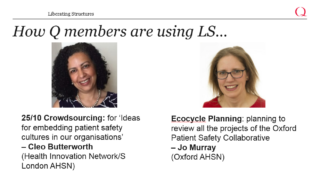
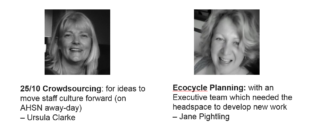 How to start your journey with using Liberating Structures?
How to start your journey with using Liberating Structures?
- Join Q’s ‘Liberating Structures in healthcare’ group
Share your experiences, challenges, questions about using Liberating Structures. View the group’s Zoom video call about how Juanita Guidera and Dr Rob Cunney’s great success in spreading the use of Liberating Structures for Improvement in Ireland (first 17 mins is intros etc, before the presentation). - Join a local user group (or start your own) – to try various Liberating Structures in a safe space.
User groups have popped up in London and Leeds; and recently two Q members started a first one in Scotland (by @KSEllis67 and @DanHarley3) and an NHS one is being mooted in Tower Hamlets (East London). - Use the Liberating Structures selection matchmaker tool – to identify which ones fit your own particular needs
You can view it here. Pick more than one to form a string, for your meeting or event. - Dive deeper – learn more about Liberating Structures
There’s a great book about Liberating Structures, a comprehensive Liberating Structures website (with everything you need, including some great new Liberating Structures in development – like Mad Tea), a free Liberating Structures app, a set of cards and a global Liberating Structures Slack group.
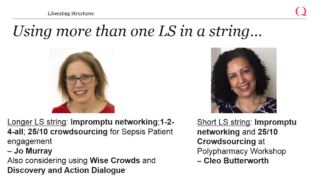
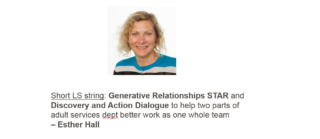 Stepping back and looking at the bigger picture around change and improvement in the NHS, and beyond, it’s interesting that Prof Mary Uhl-Bien’s study into how successful change happens in healthcare organisations and elsewhere sees a crucial role for Liberating Structures.
Stepping back and looking at the bigger picture around change and improvement in the NHS, and beyond, it’s interesting that Prof Mary Uhl-Bien’s study into how successful change happens in healthcare organisations and elsewhere sees a crucial role for Liberating Structures.
For new ideas (often coming from the informal networks of innovators/entrepreneurs) to be able to flow through and embed into our formal productive organisations, a third space is required, which she calls ‘Adaptive space’. Liberating Structures – along with Labs, Communities of Practice, Design Thinking, Positive Deviance and much else – are tools that help create these – often temporary – spaces. (Mary explains her framework in this fabulous Q community SIG Zoom video; and here’s one article by her that shows Liberating Structures’ role in enabling adaptive change to create agile organisations that thrive in uncertain times).
Join a Q Community Liberating Structures immersion workshop
Q is offering two workshops where Q member can learn how to use Liberating Structures – they’re a really enjoyable and hands-on opportunity to get started with trying out some Liberating Structures. The workshops are on Wednesday 28 November or Monday 3 December 2018 in London -don’t miss the opportunity!
Link
* Zoe Lord’s slides for the session